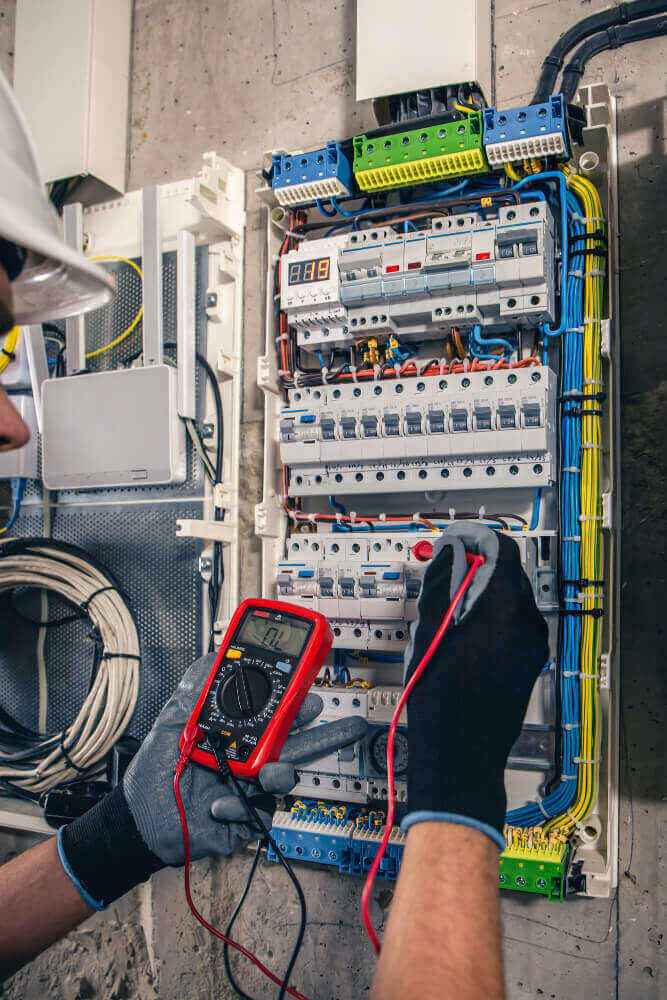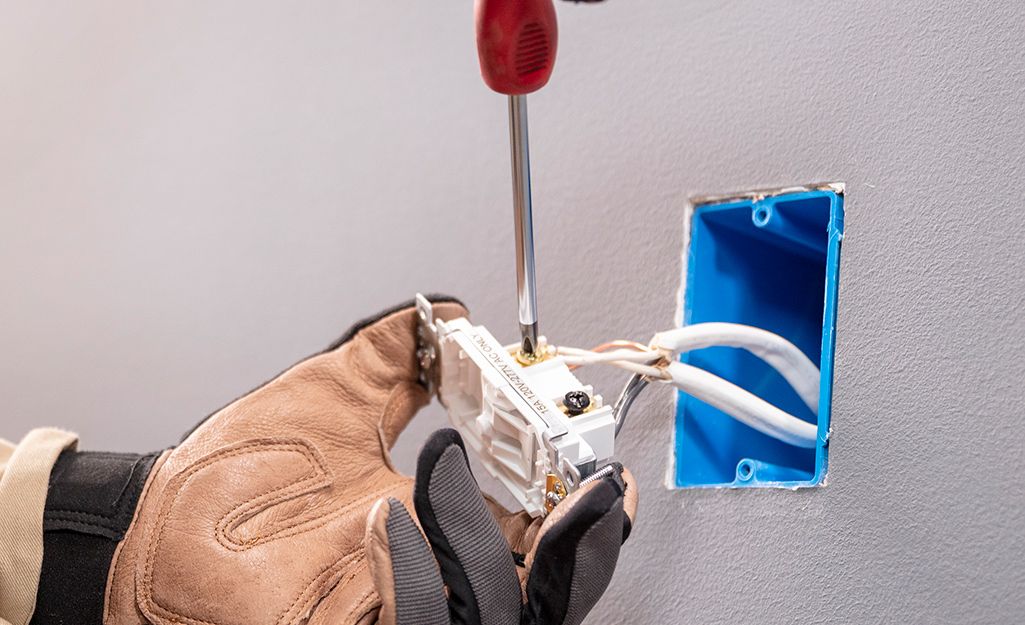Table of Contents

Households can face several electrical problems with time. These electrical issues can prevent you from operating your appliances and threaten your life and your loved ones. Electrical safety, therefore, should be ensured throughout your home and electrical maintenance, repairs, and installations should only be performed by certified electricians. For your knowledge, we are sharing some of the most common electrical problems that domestic users may face. These include the following:
- Power Outage: A power outage can be caused by several factors, such as lightning strikes, high winds, overloaded circuits, or a problem with the electrical grid.
- Circuit Breaker Tripping: This occurs when the circuit breaker cuts off power to the circuit. It can be caused by overloading the circuit, a short circuit, or a ground fault.
- Flickering Lights: Flickering lights can be caused by a loose bulb, faulty wiring, or an overloaded circuit.
- Outlet Not Working: If an outlet is not working, it could be due to a tripped circuit breaker, a faulty outlet, or a wiring issue.
- Electrical Shocks: Electrical shocks can occur when you touch an appliance or switch. Faulty wiring, a ground fault, or a damaged appliance can cause this.
- High Electricity Bills: High electricity bills can be caused by inefficient appliances, poor insulation, or an old heating and cooling system.
- Buzzing or Humming Sounds: Buzzing or humming sounds can be caused by a loose connection, faulty wiring, or a problem with the electrical panel.
- Burning Smell: In case of a Burning odour coming from an appliance or outlet, turn off the power immediately and call an electrician. Issues such as faulty wiring or an overloaded circuit may be the cause.
Causes of Home Circuit Breaker Tripping
Circuit Breakers are designed to switch off or trip the power supply when there is an overload or short circuit in the circuit. Here are some common causes of home circuit breaker tripping:
- Overloading the Circuit: Too many electrical devices connected to a single circuit can overload it and cause the circuit breaker to trip. This is especially common in older homes where circuits may need to be designed to handle modern electrical demands.
- Short Circuit: Short-circuiting occurs when the hot and neutral wires touch or when a damaged wire is damaged. This causes a sudden increase in current, which can trip the circuit breaker.
- Ground Fault: Ground faults occur when the hot wire touches a ground wire or a metal object connected to the ground. This can also cause a sudden increase in current, which trips the circuit breaker.
- Faulty Circuit Breaker: Sometimes, the circuit breaker can be faulty and trip even with no overload or short circuit. This can be caused by age, wear and tear, or other factors.
- Electrical Surge: An electrical surge can occur when a sudden voltage increases in the electrical system. This can happen during lightning strikes or when the power is revived after a power outage.
Electrical Safety Certificates
24Hr Emergency Electricians
Our team of emergency response electricians are on call 24/7
Fair Price
Our pricing structure is transparent and affordable. We offering great value for money
Causes of Electric Shocks
Electric shocks can be dangerous and even life-threatening, so it’s essential to understand the causes and take measures to prevent them. Here are some common causes of electric shocks:
- Faulty Wiring: Faulty or damaged wiring can expose live wires and cause electric shocks. Wiring can damage over time due to wear and tear, rodents, or other factors.
- Ground Fault: A ground fault occurs when an electrical current flows through a person’s body to the ground. This can happen when a faulty appliance, tool or device is not properly grounded or when there is an issue with the electrical system.
- Wet Conditions: Water is a good conductor of electricity, and wet conditions can increase the risk of electric shocks. For example, touching an electrical device with wet hands can cause electric shock.
- Damaged Electrical Appliances: Damaged electrical appliances can also cause electric shocks. For example, a frayed cord or a damaged plug can expose live wires and increase the risk of electric shock.
- DIY Electrical Work: Attempting DIY electrical work without proper knowledge and tools can increase the risk of electric shocks. Hiring a licensed electrician for any electrical work in your home is essential.
- Lightning Strikes: Lightning strikes can cause electrical surges that can travel through electrical wiring and cause electric shocks.
Dangers of Faulty or Low-Quality Wiring
Faulty or low-quality wiring can pose significant dangers to your home and family. Here are some of the potential risks of defective or low-quality wiring:
- Electrical Fires: Faulty or low-quality wiring can overheat and ignite surrounding materials, causing fires that can spread quickly and cause extensive damage.
- Electrical Shock: Damaged or exposed wiring can cause electrical shocks that can be fatal, especially if the voltage is high.
- Increased Risk of Electrocution: Poor wiring can increase the risk of electrocution, especially in wet areas such as bathrooms, kitchens, and basements.
- High Energy Bills: Faulty wiring can cause electrical appliances to operate inefficiently, leading to higher energy bills.
- Damage to Electrical Appliances: Low-quality wiring can cause electrical appliances to operate improperly, leading to damage or failure of the appliance.
- Inability to Meet Electrical Demands: Faulty or low-quality wiring may not meet modern appliances’ electrical demands, causing circuit overloads and tripping circuit breakers.


contact us now
if you need Any Assistance
We’re available to look after your electrical emergency 24h a day.
Causes of Sparking and Buzzing
Sparking and buzzing are signs of potential electrical problems and should be addressed promptly to prevent electrical hazards. Here are some common causes of sparking and buzzing in electrical systems:
- Loose Connections: Loose electrical connections can cause sparking and buzzing. This can happen when wires are not correctly secured or terminals are loose.
- Overloaded Circuits: Overloading circuits can cause excessive heat buildup and lead to sparking and buzzing.
- Damaged or Worn-Out Electrical Components: Damaged or worn-out electrical components such as switches, outlets, and circuit breakers can cause sparking and buzzing. This can happen due to age, wear and tear, or physical damage.
- Faulty Appliances: Faulty electrical appliances can also cause sparking and buzzing. This can happen when the appliance’s electrical system is damaged or when the appliance is improperly wired.
- Electrical Surges: Electrical surges can cause sparking and buzzing by overloading the electrical system.
- Poor Wiring: Poor wiring, such as exposed or improperly installed wiring, can cause sparking and buzzing.
Problems with Old Consumer Units
Consumer units, also known as fuse boxes, are an essential component of a building’s electrical system and protect the building from electrical faults and overloads. Here are some problems associated with old consumer units:
- Lack of Safety Features: Older consumer units may not have the latest safety features, such as RCDs (Residual Current Devices) or RCBOs (Residual Current Circuit Breakers with Overcurrent protection), which can increase the risk of electrical hazards such as electric shocks, electrocution, and electrical fires.
- Overloaded Circuits: Older consumer units may not be able to handle the electrical demands of modern appliances and may be prone to circuit overloads, which can cause the unit to trip or even catch fire.
- Poor Wiring Connections: Over time, the wiring connections in an old consumer unit can become loose or corroded, leading to electrical faults and an increased risk of electrical hazards.
- Inadequate Protection: Older consumer units may need protection against electrical faults and overloads, which can put the building and its occupants at risk.
- Non-Compliance with Regulations: Older consumer units may need to comply with the latest electrical safety regulations, resulting in legal issues and difficulties obtaining insurance.
Benefits of the Electrical Installation Condition Report
Electrical Installation Condition Reports are an assessment of the electrical installation in a building to ensure that it is safe and compliant with the relevant electrical safety standards. The EICR offers several benefits:
- Ensures Safety: The primary benefit of having an EICR is that it ensures the safety of the building’s occupants. An EICR will identify potential electrical hazards, such as overloaded circuits and faulty wiring, and recommend the necessary repairs or upgrades to keep the electrical system safe.
- Compliance with Regulations: An EICR is required by law for certain types of buildings, such as rental properties. It can help ensure the building complies with the relevant electrical safety regulations.
- Reduces Risk of Electrical Fires: Electrical fires can be caused by faulty electrical installations or appliances, and an EICR can identify potential risks and recommend the necessary repairs or upgrades to reduce the risk of electrical fires.
- Saves Money: An EICR can identify any energy inefficiencies in the electrical system and recommend upgrades or repairs to reduce energy consumption and save money on energy bills.
- Improves Property Value: A building with a valid EICR is more attractive to potential buyers or tenants as it demonstrates that the electrical installation has been inspected and is safe and compliant.
